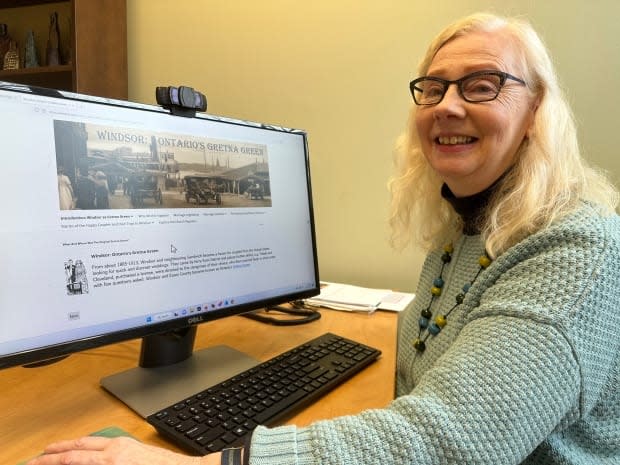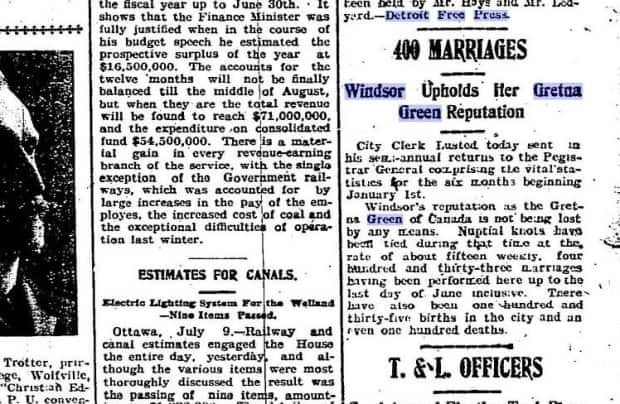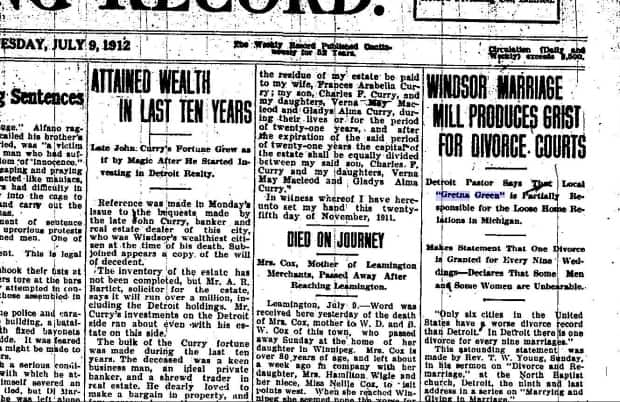Here's why Windsor was known as a 'marriage mill' for quickie American weddings

As Windsor, Ont., librarian Katharine Ball was digitizing old church records, she became perplexed — local clergy had been officiating a lot of marriages.
Provincial records showed Ball there was an "extraordinary" number of weddings between American couples in the region between 1875 and 1913.
Scouring through old digital newspapers, Ball quickly discovered this wasn't because Windsor was a love destination — rather, the city was taking part in a lucrative business.
"The story had been forgotten — it just sort of revealed itself by layers," said Ball, who created a website breaking down the phenomenon.
Windsor's reputation as a wedding destination was the result of changes to Ontario's marriage act in 1875, which made its marriage rules more lax than those in the United States.
"[The changes] made it easier for non-residents to get married here. There was no waiting period, no residency requirements, and you basically had to say you were of age and there was no reason why you couldn't get married," said Ball.
Tom Vajdik, local history librarian with Windsor Public Library, said there were fewer questions, which made the process a lot easier.
"They would come here, get a licence and find a minister or a priest and get married here in Windsor," he said.

This led to quite the booming business, for the clergymen and for people who sold marriage licences, flowers and dresses, along with those who supplied rooms for the new couples.
Windsor was Ontario's 'Gretna Green'
Eventually, the city became known as "Ontario's Gretna Green."
In Scotland, Gretna Green was a small village where young English couples ran away to to get married. This happened more than 100 years before Windsor saw a similar trend with the U.S.

Runaway lovers whose parents didn't approve, couples with a large age difference, divorcees and first cousins all found it easier to marry in Windsor, said Ball.
Couples would arrive to the region by ferry, throw together a quick ceremony and sign a licence.
"There's a story, for example, about one couple that actually, I guess they must have arrived fairly late, they actually woke the minister up, dragged him out of bed and so they were actually married in his house," she said, adding that on occasion, the wives of ministers or housekeepers would serve as witnesses to the marriage.

In another instance, an article reported on the Windsor marriage of a couple with a 51-year age gap. The article states, "Mrs. Love Foster, 77, and Charles Mardon, 26, journey to Windsor Gretna Green, where knot is effectually tied."
At the time, Windsor's Evening Record newspaper reported on it as a booming business, but the Detroit Free Press saw what was happening as detrimental.
The paper often reported the city was running a "marriage mill" and pegged it as the reason behind Detroit's high divorce rate.
"The Windsor marriage mill produces grist for the Detroit divorce mill," reads a line from the Evening Record's July 9, 1912 paper.
Local newspapers wrote many stories about the issue over the years, with headlines like "Wed in Windsor, Repent Later," and "Windsor's ministers are rearing a rich harvest."
Government makes changes after weddings peak
An article from the July 9, 1904, Evening Record newspaper said that between January and the end of June that year, about 15 weddings had been happening per week, with a total of 433 marriages taking place within those six months.
By 1912, Ball said, the number of marriages had peaked — Windsor saw about 176 marriages per 1,000 people, while the provincial average was about 12 or 13 per 1,000 people.
"So it was totally out of control," Ball said with a laugh.
"They tried to introduce reforms earlier, but they had failed."
In 1913, the Ontario government introduced new rules that required you to live in the area you planned to get married in for 15 days or have previously advertised the wedding.
After this came into effect, the number of marriages in the province dropped.
Despite the controversial business and its sudden demise, Ball said she still believes Windsor is a city of love.
"Of course it's a love city. How could you say otherwise?" said Ball.


